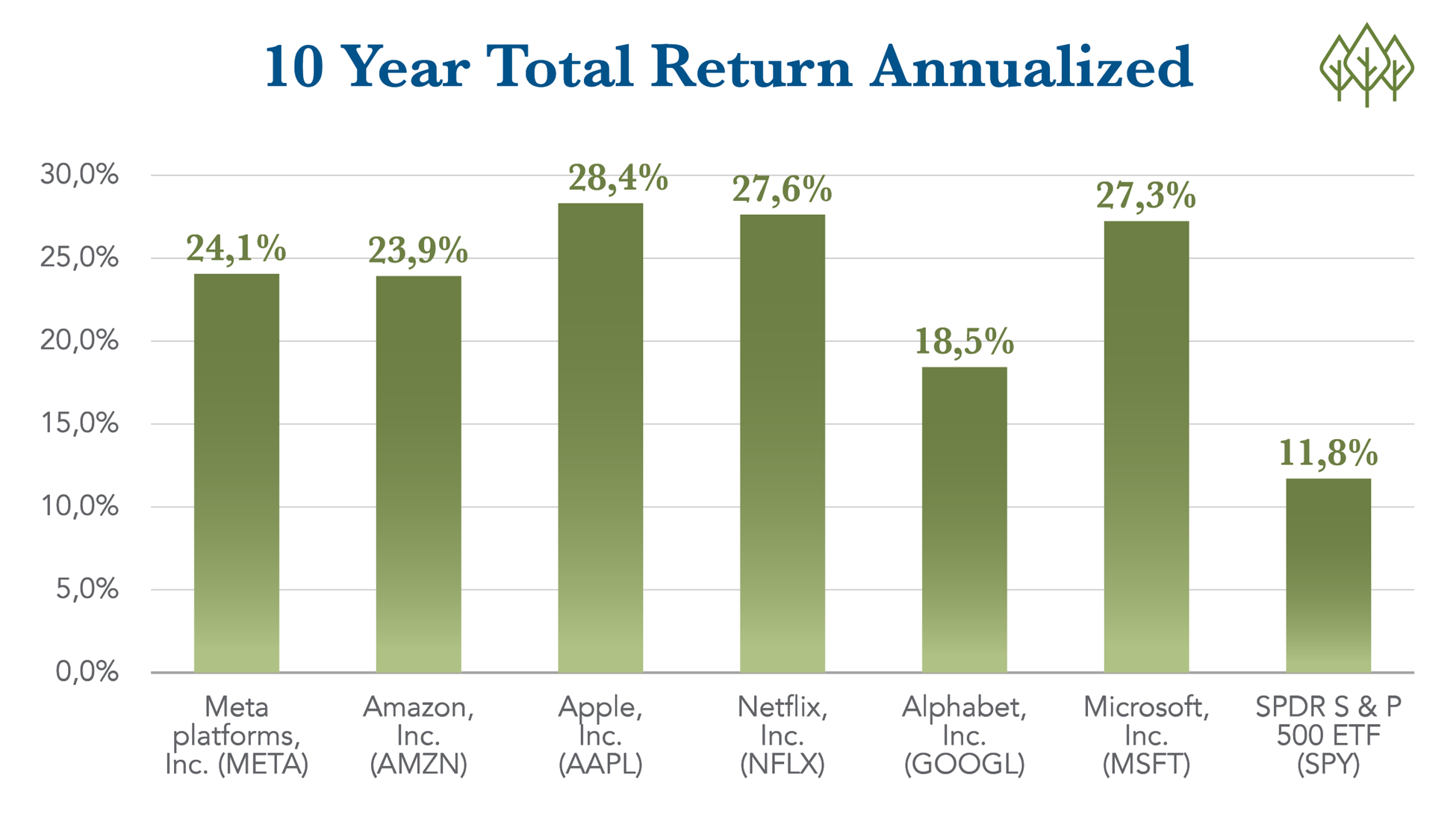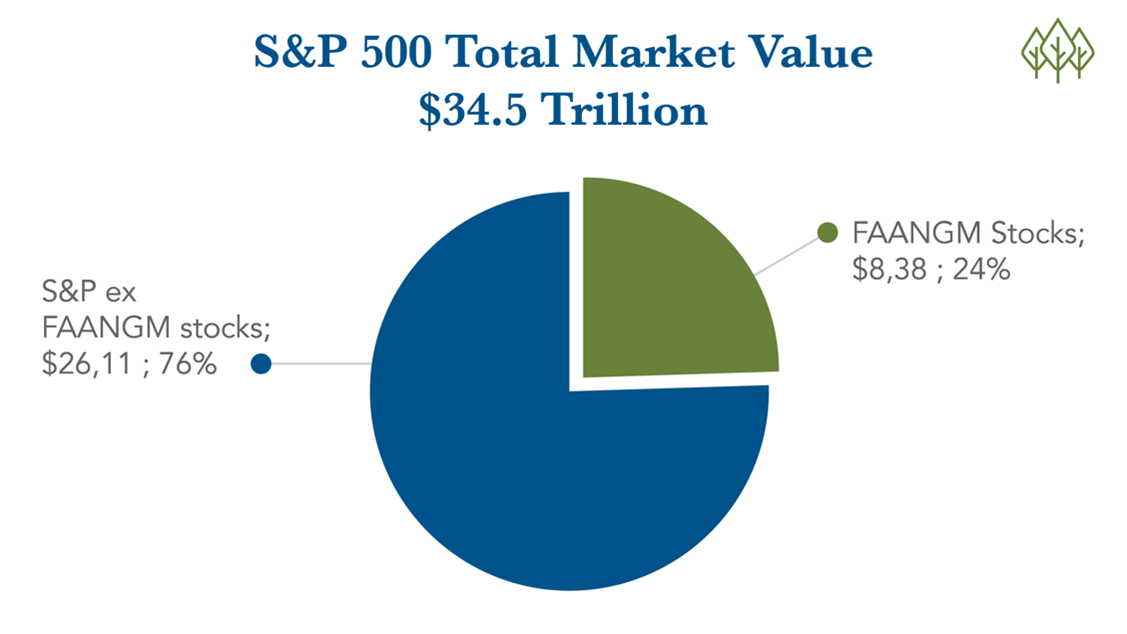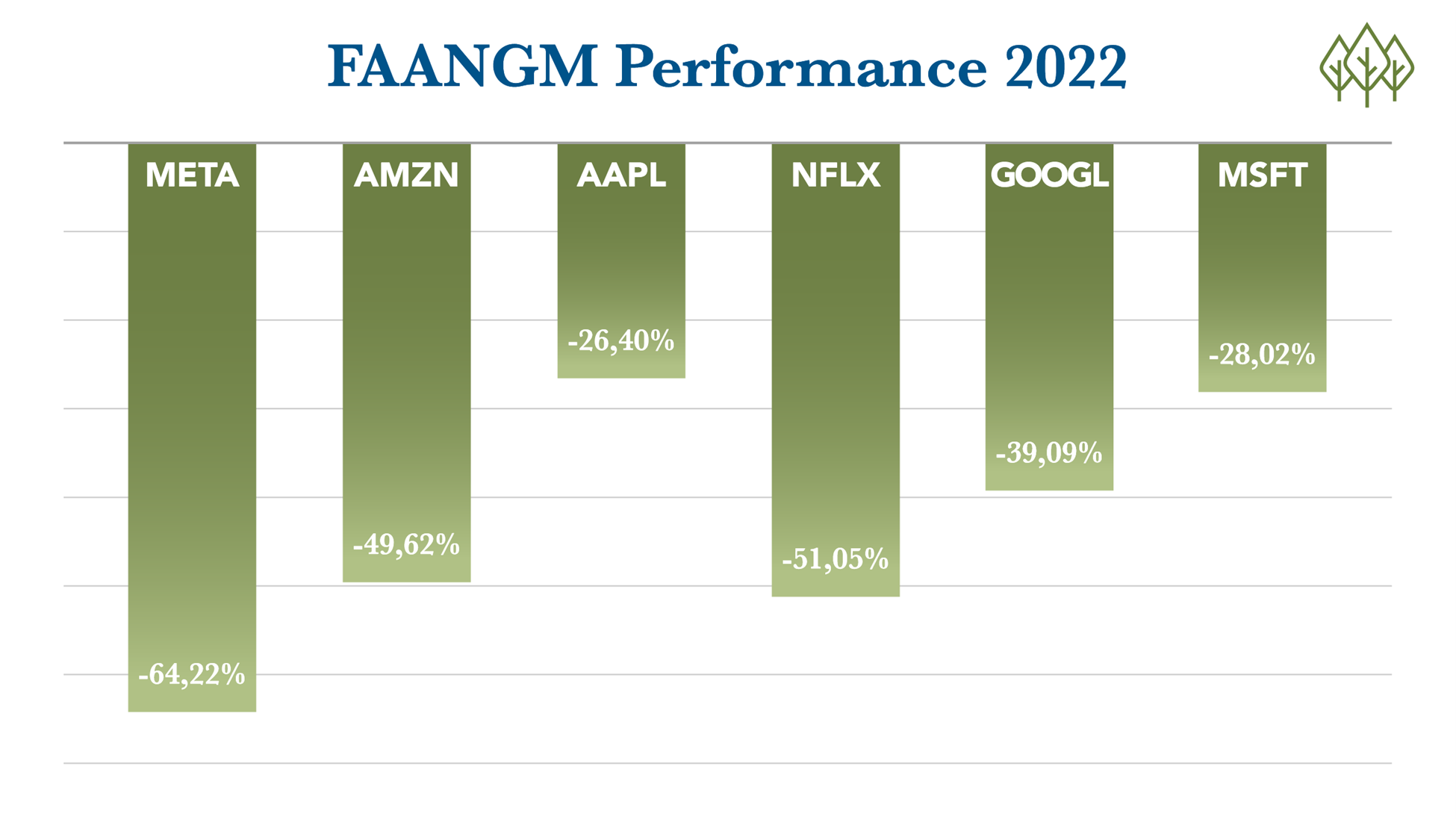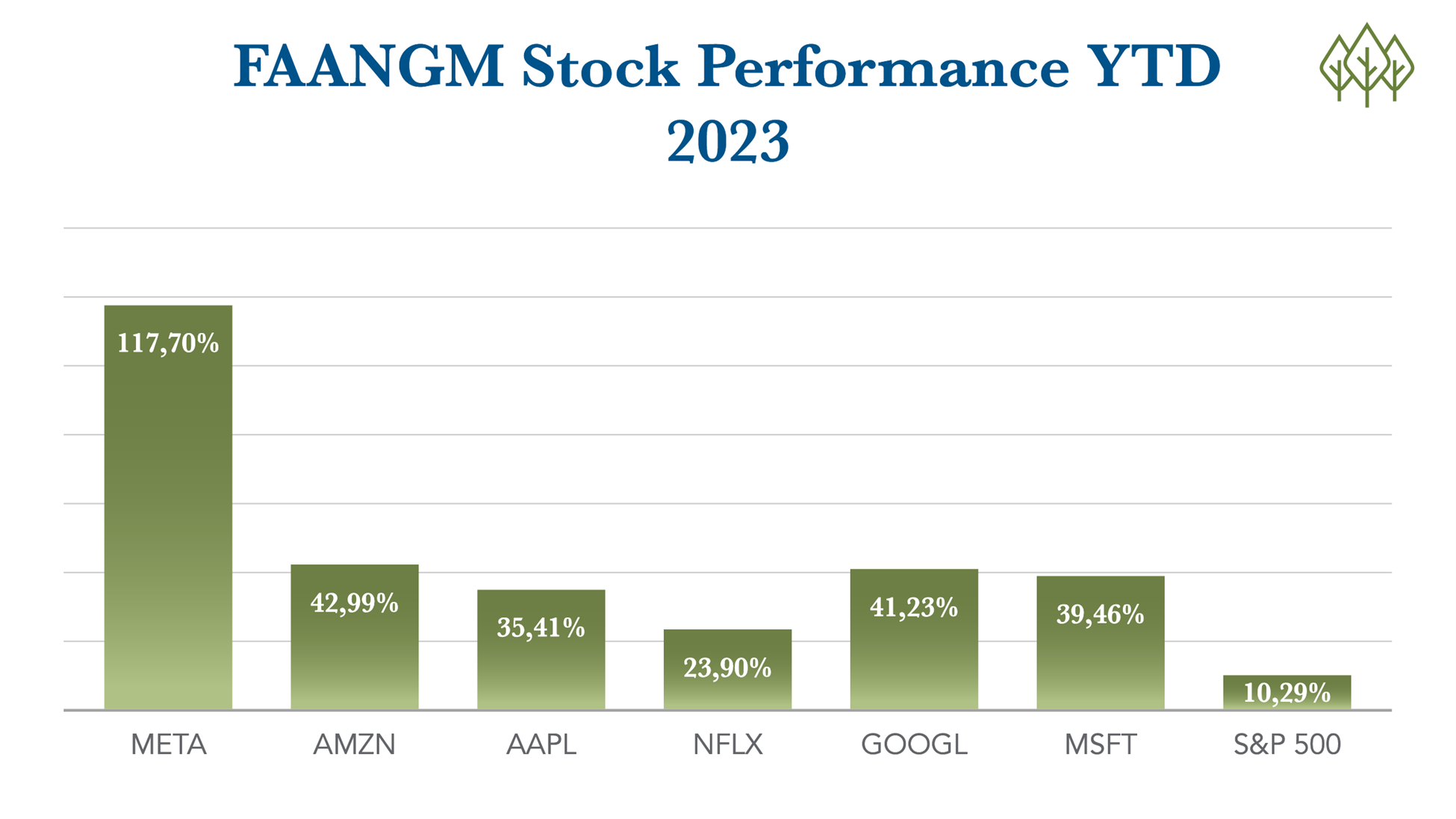FAANGs for the Memories: Do Technology Stocks Still Have Teeth?
by Ellen Knox, SVP, Portfolio Manager
Tech stocks have been among the top-performing investments for over a decade. Over the past ten years, the Information Technology (IT) sector of the S&P 500 has returned an average of 20.09% annually, compared to 11.56% for the S&P 500. Since 2010, five stocks have been consistently among the highest growth stocks in the market.
- Meta (META - formerly known as Facebook)
- Amazon (AMZN)
- Apple (AAPL)
- Netflix (NFLX)
- Alphabet (GOOGL - formerly known as Google)
The stocks listed above were collectively known as the FAANG stocks, an acronym popularized by Jim Cramer, the television host of CNBC’s Mad Money in 2013. Some have added Microsoft to the list of dazzling FAANG stocks, thus changing the acronym to FAANGM.
Historically, FAANGM has delivered phenomenal results.

*Source: Morningstar.com
As depicted in the table below, FAANGM stocks comprise 24% of the market value of the S&P 500.

*Source: Yahoo Finance
While the performance of these stocks over time has been stellar, 2022 was an abysmal year for FAANGM and technology stocks in general.

*Source Y Charts
In 2022, the tech-heavy Nasdaq Composite index was the worst performer among the three most widely followed US indexes, dropping 33.1% for the year. The S&P 500 Information Tech sector declined 28.2%. Ark Innovation EFT (ARKK), a technology disruptor fund run by Cathie Wood, dropped a whopping -66.97% in 2022. Why did the tech darlings fall from grace?
The rapidly rising interest rates in 2022 can explain much of the underperformance. The Federal Reserve raised interest rates seven times in 2022. Rates increased from the range of 0 - .25% at the beginning of the year to a range of 4.25% - 4.5% at year-end, a 15-year high.
The rate hikes negatively affected a widely used equity valuation metric called the “Discounted Cash Flow” model. This model uses a discount rate to determine the present value of expected future cash flows. The discount rate is usually the weighted average cost of capital, which incorporates the conditions of the capital markets. If interest rates rise, future cash flows (earnings, dividends) are divided by a higher cost of capital rate (which is the denominator in the equation) to find the present value. This higher denominator translates to a lower present value for a growth stock. IT stock prices reset in 2022 to reflect this.
Rates have continued to rise in 2023. The Federal Reserve has raised rates three times so far this year, bringing the target Fed Funds Rate to 5% - 5.5%. Jerome Powell, Chair of the Federal Reserve, has stated that the Fed is close to the end of the rate hikes, if not at the end.
Markets are forward-looking. The anticipation of the end of this series of rate hikes and even a possible pivot to lower rates has resulted in growth stocks rising once again in 2023.

*Source Y Charts. Data through 5/26/2023
Tech stocks, along with high-growth stocks in general, are by nature more volatile than some of the slower-growth, high dividend-paying stocks. We can expect volatility to continue.
Some of the additional risks that tech stocks face:
- Regulatory risks – Privacy, antitrust and content oversight from US regulators and regulators abroad will have an impact on the sector’s growth.
- Competition – The field is fiercely competitive. The ability to plow resources into R&D to enhance capabilities is critical.
- Geopolitical factors – Heightened tensions among world leaders can hamper global trade and cause supply pipeline shortages.
- Global slowdown – If the global economy slows down in the near term, as some expect, the sector's top-line growth and margins could suffer.
There will always be risks in investing, particularly in rapidly changing sectors. However, some say that today, we are facing a fourth industrial revolution resulting from the confluence of multiple technology trends at once. These trends will alter the way we do business and live our lives. In an article written 1/5/2022 called “The 10 Trends That Will Transform our World,” Forbes magazine lists the following groundbreaking trends.
1. Ubiquitous computing
Computers are all around us now: in our phones, on our wrists, in our cars, and in our homes. As processing power has increased, the size of computer chips has shrunk, resulting in smaller, cheaper, more powerful, and more pervasive computers and devices. Additionally, we are making progress in developing quantum computers. These computers are so fast and powerful that they will be used to complete new, previously impossible tasks.
2. Connected and smart everything
This is often referred to as the Internet of Things (IoT). Everything that can be connected will be, including smart, connected factories, smart cities, smart power grids, and more.
3. The datafication of our world
In addition to machine-generated data, humans are also generating masses of data through our daily activities.
4. Artificial Intelligence (AI)
All the data being generated is a core enabler for AI. We are only at the start of this phenomenon. All industries will use this capability in some capacity.
5. Extended reality (XR)
XR is an umbrella term representing a spectrum of immersive technologies: virtual reality, augmented reality, and mixed reality. Gaming was primarily identified with XR, but this technology will increasingly be used in education, healthcare, real estate, e-commerce, and retail, to name a few.
6. Digital trust
Digital trust involves building a secure digital world where transactions can happen safely, easily, and securely. Our connectivity brings an urgent need to safeguard networks and data. Cybersecurity is vital in this effort.
7. 3D Printing
This has the potential to transform manufacturing and to make things that can’t easily be made with traditional methods, while eliminating waste and reducing costs.
8. Gene-editing and synthetic biology
Gene editing can, in theory, alter “bad” genes that endanger the health of an organism. Synthetic biology can involve stitching together long strands of DNA and inserting the strands into an organism. As a result, the organism may have entirely new abilities.
9. Nanotechnology and materials science
Nanotechnology is the science of controlling matter on a tiny scale, for instance, at the atomic or molecular level. Materials science is the study of manipulating materials. New and advanced materials that are being developed include nanomaterials, biomaterials, and energy materials.
10. New energy solutions
New energy solutions such as nuclear fusion and green hydrogen are making headway.
This seems like a lot to chew on, but there are many ways to participate in the tech confluence.
If you own an ETF that represents the S&P 500, you have a 26.4% allocation to the technology sector. As stated above, an S&P 500 ETF contains a 24% stake in the FAANGM stocks (Alphabet, Meta, and Netflix are in the S&P Communication Services sector, and Amazon is in the S&P Consumer Discretionary sector). Most US growth mutual funds and ETFs will have exposure to tech stocks. There are also mutual funds and ETFs devoted solely to the technology sector.
While the FAANGM stocks enjoy a high profile, there are many other promising publicly traded technology stocks. Companies with strong financials, good cash flow, and wide moats are desirable. Typically, tech stocks are not cheap, so if you find a company you want to own, it may pay to buy it during a market downturn or when the company is suffering from bad news that you think is temporary. Given the sector's volatility, it helps to have a long time horizon and a tolerance for price swings.
Events are rapidly evolving, which will deliver change. Change presents opportunities. All signs indicate that tech stocks aren’t long in the tooth yet.